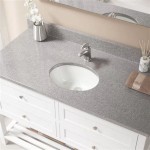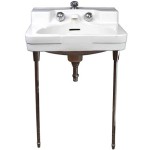How to Choose Bathroom Faucet Height
A bathroom faucet is a crucial element that impacts both functionality and aesthetics. Beyond its basic function of dispensing water, the faucet's height plays a significant role in achieving the desired comfort, accessibility, and design harmony. Selecting the appropriate faucet height requires careful consideration of various factors, from personal preferences to specific bathroom layouts. This article explores key factors to consider when choosing the ideal bathroom faucet height, providing insights to guide informed decisions.
1. Sink Type and Depth
The type and depth of the sink significantly influence the required faucet height. For example, a vessel sink, which sits above the countertop, typically demands a higher faucet to ensure adequate clearance for washing hands and faces comfortably. Conversely, undermount sinks, seamlessly integrated into the countertop, often require lower faucets for optimal functionality. Bathroom sinks with deeper bowls may benefit from slightly taller faucets, while shallower sinks require faucets closer to the countertop.
When choosing a bathroom faucet height, it's essential to consider the sink's dimensions and the desired clearance between the faucet spout and the sink basin. A rule of thumb is to ensure a minimum of 6 inches of clearance between the spout and the sink bowl to prevent splashing and ensure comfortable use.
2. User Height and Ergonomics
The height of the bathroom users is another crucial determinant of faucet height. Tall individuals might prefer higher faucets for ease of access, while shorter users may find lower faucets more comfortable. The goal is to select a faucet height that allows for a relaxed posture while using the sink, eliminating the need to awkwardly bend or reach.
Ergonomic considerations play a significant role in achieving comfort and functionality. Ideally, the water spout should be positioned at a height that allows water to flow directly into the sink without splashing or requiring excessive tilting of the head. This involves finding a balance between faucet height, sink depth, and user height. For example, in a bathroom shared by people with varying heights, a faucet with a slightly higher spout could be more accommodating to taller users while still being accessible to shorter individuals.
3. Design and Style Considerations
The design and style of the bathroom faucet can also impact its height. Modern, minimalist faucets often feature sleek, low-profile designs, often with shorter spouts. Traditional faucets, on the other hand, might have taller spouts and decorative details, which could influence the overall height. The choice of design should complement the overall aesthetic of the bathroom and the style of other fixtures.
It's important to note that the distance between the faucet base and the spout can vary across different models. This variation in design can affect the overall height of the faucet, even if the same sink is used. Therefore, it's essential to consider the specific dimensions of the chosen faucet model to ensure it aligns with the desired height and design aesthetic.
4. Clearance and Accessibility
The space available around the sink is another significant factor in determining the appropriate faucet height. Adequate clearance allows easy movement around the sink and prevents accidental bumps or obstructions. If a narrow space is a concern, selecting a lower faucet with a shorter spout might be a better option. Conversely, ample space could accommodate a faucet with a taller spout or more intricate design.
Accessibility is also a critical consideration, especially in bathrooms designed for individuals with mobility limitations. A lower faucet height with a lever handle can enhance accessibility and ease of use, making the sink more user-friendly for individuals with limited hand strength or dexterity.
5. Professional Guidance and Installation
While this article provides valuable information for choosing the right bathroom faucet height, seeking professional guidance from a plumber or experienced bathroom designer can offer personalized recommendations tailored to your specific situation and preferences.
A plumber can assess the existing bathroom layout, sink dimensions, and consider any accessibility requirements. They can provide expert advice on the ideal faucet height based on practical considerations and local building codes. Additionally, a professional plumber can handle the installation process ensuring that the chosen faucet is installed correctly and securely, guaranteeing its functionality and longevity.
In conclusion, selecting the optimal bathroom faucet height requires a comprehensive approach, considering factors such as sink type, user height, design preferences, and accessibility. By carefully evaluating these factors and seeking professional guidance when needed, you can choose a faucet that enhances both functionality and aesthetic appeal, creating a bathroom that is both comfortable and stylish.

Bathroom Faucet Guide

How To Choose Bathroom Faucet New Style

How To Choose The Right Faucet For Your Bathroom Sarasota

Your Guide To A Bathroom Faucet

How To Choose A New Bathroom Sink Faucet Vevano

Bathroom Faucet Guide
How To Choose A New Bathroom Sink Faucet Vevano

How To Measure A Bathroom Faucet The Home Depot

How To Measure A Bathroom Faucet The Home Depot

Tips On Choosing A Faucet
Related Posts







